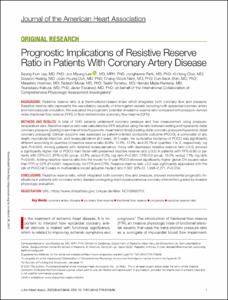KUMEL Repository
1. Journal Papers (연구논문)
1. School of Medicine (의과대학)
Dept. of Internal Medicine (내과학)
Prognostic Implications of Resistive Reserve Ratio in Patients With Coronary Artery Disease
- Affiliated Author(s)
- 남창욱
- Alternative Author(s)
- Nam, Chang Wook
- Journal Title
- Journal of the American Heart Association
- ISSN
- 2047-9980
- Issued Date
- 2020
- Keyword
- coronary artery disease; coronary flow reserve; fractional flow reserve; prognosis; resistive reserve ratio
- Abstract
- Background:
Resistive reserve ratio is a thermodilution-based index which integrates both coronary flow and pressure. Resistive reserve ratio represents the vasodilatory capacity of interrogated vessels including both epicardial coronary artery and microvascular circulation. We evaluated the prognostic potential of resistive reserve ratio compared with pressure-derived index (fractional flow reserve [FFR]) or flow-derived index (coronary flow reserve [CFR]).
Methods and Results:
A total of 1245 patients underwent coronary pressure and flow measurement using pressure-temperature wire. Resistive reserve ratio was calculated by CFR adjusted using the ratio between resting and hyperemic distal coronary pressure ([resting mean transit time/hyperemic mean transit time]×[resting distal coronary pressure/hyperemic distal coronary pressure]). Clinical outcome was assessed by patient-oriented composite outcome (POCO), a composite of any death, myocardial infarction, and revascularization at 5 years. At 5 years, the cumulative incidence of POCO was significantly different according to quartiles of resistive reserve ratio (9.9%, 11.3%, 17.2%, and 22.7% in quartiles 1 to 4, respectively, log rank P<0.001). Among patients with deferred revascularization, those with depressed resistive reserve ratio (<3.5) showed a significantly higher risk of POCO than those with preserved resistive reserve ratio (≥3.5) in patients with FFR>0.80 or patients with CFR>2.0. (FFR>0.80 group: 14.8% versus 6.0%; log rank P=0.001; CFR>2.0 group: 13.5% versus 7.1%; log rank P=0.045). Adding resistive reserve ratio into the model for 5-year POCO showed significantly higher global Chi square value than FFR or CFR (P<0.001, respectively, for FFR and CFR). Resistive reserve ratio <3.5 was significantly associated with the risk of POCO at 5 years in multivariable model (adjusted hazard ratio 1.597, 95% CI, 1.098-2.271, P=0.014).
Conclusions:
Resistive reserve ratio, which integrated both coronary flow and pressure, showed incremental prognostic implications in patients with coronary artery disease undergoing elective percutaneous coronary intervention guided by invasive physiologic evaluation.
- Department
- Dept. of Internal Medicine (내과학)
- Publisher
- School of Medicine (의과대학)
- Citation
- Seung Hun Lee et al. (2020). Prognostic Implications of Resistive Reserve Ratio in Patients With Coronary Artery Disease. Journal of the American Heart Association, 9(8), e15846. doi: 10.1161/JAHA.119.015846
- Type
- Article
- ISSN
- 2047-9980
- Appears in Collections:
- 1. School of Medicine (의과대학) > Dept. of Internal Medicine (내과학)
- 파일 목록
-
-
Download
 oak-2020-0366.pdf
기타 데이터 / 1.5 MB / Adobe PDF
oak-2020-0366.pdf
기타 데이터 / 1.5 MB / Adobe PDF
-
Items in Repository are protected by copyright, with all rights reserved, unless otherwise indicated.